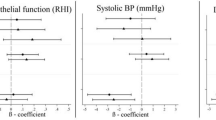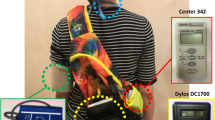Abstract
The objective was to explore associations of chemical components and source factors of ambient fine particulate matter (aerodynamic diameter ≤2.5 μm; PM2.5) with cardiovascular (CV) changes following same-day exposure to ambient PM2.5. Twenty-five healthy adults living in rural Michigan were exposed to ambient air in an urban/industrial community for 4 to 5 h daily for five consecutive days. CV health outcomes were measured 1–2 h post exposure. Contributing emission sources were identified via positive matrix factorization. We examined associations between PM2.5 mass, composition and source factors, and same-day changes in CV outcomes using mixed-model analyses. PM2.5 mass (10.8±6.8 μg/m3), even at low ambient levels, was significantly associated with increased heart rate (HR). Trace elements as well as secondary aerosol, diesel/urban dust and iron/steel manufacturing factors potentially explained the HR changes. However, trace element analysis demonstrated additional associations with other CV responses including changes in blood pressure (BP), arterial compliance, autonomic balance and trends toward reductions in endothelial function. Two factors were related to BP changes (diesel/urban dust, motor vehicle) and trends toward impaired endothelial function (diesel/urban dust). This study indicates composition of PM2.5 and its sources may contribute to CV health effects independently of PM2.5 mass.
This is a preview of subscription content, access via your institution
Access options
Subscribe to this journal
Receive 6 print issues and online access
$259.00 per year
only $43.17 per issue
Buy this article
- Purchase on Springer Link
- Instant access to full article PDF
Prices may be subject to local taxes which are calculated during checkout



Similar content being viewed by others
References
Brook RD, Rajagopalan S, Pope CA, III, Brook JR, Bhatnagar A, Diez-Roux A et al. Particulate matter air pollution and cardiovascular disease. An update to the scientific statement from the American Heart Association. Circulation 2010; 121: 2331–2378.
Dominici F, Peng RD, Barr CD, Bell ML . Protecting human health from air pollution: shifting from a single-pollutant to a multi-pollutant approach. Epidemiology 2010; 21: 187–194.
Mar TF, Koenig JQ, Larson TV, Christensen W, Eatough DJ, Henry RC et al. PM source apportionment and health effects. III. Investigation of inter-method variations in associations between estimated source contributions of PM2.5 and daily mortality in Phoenix, AZ. J Expo Anal Environ Epidemiol 2006; 16: 311–320.
Sarnat JA, Marmur A, Klein M, Kim E, Russell AG, Sarnat SE et al. Fine particle sources and cardiorespiratory morbidity: an application of chemical mass balance and factor analytical source-apportionment methods. Environ Health Perspect 2008; 116: 459–466.
Ito K, Mathes R, Ross Z, Nádas A, Thurston G, Matte T . Fine particulate matter constituents associated with cardiovascular hospitalizations and mortality in New York City. Environ Health Perspect 2011; 119: 467–473.
Lall R, Ito K, Thurston G . Distributed lag analyses of daily hospital admissions and source-apportioned fine particle air pollution. Environ Health Perspect 2011; 119: 455–460.
Ostro B, Tobias A, Querol X, Alastuey A, Amato F, Pey J et al. The effects of particulate matter sources on daily mortality: a case-crossover study of Barcelona, Spain. Environ Health Perspect 2011; 119: 1781–1787.
Rohr AC, Kamal AS, Morishita M, Mukherjee B, Keeler GJ, Harkema JR et al. Altered heart rate variability in spontaneously hypertensive rats is associated with specific particulate matter components in Detroit, Michigan. Environ Health Perspect 2011; 119: 474–480.
Oakes M, Rastogi N, Majestic BJ, Shafer M, Schauer JJ, Edgerton ES et al. Characterization of soluble iron in urban aerosols using near‐real time data. J Geophys Res 2010; 115: D15302.
USEPA AirDATA. Office of Air and Radiation. NEI Database 2008a.
USEPA Clean Air Status and Trends Network (CASTNET) http://java.epa.gov/castnet/viewsiteinfo.do?siteId=ANA115 EPA Clean Air Markets Division 2009.
Langrish JP, Mills NL, Chan JKK, Leseman DLAC, Aitken RJ, Fokkens PHB et al. Beneficial cardiovascular effects of reducing exposure to particulate air pollution with a simple face mask. Particle Fibre Toxicol 2009; 6: 8.
USEPA Reference method for the determination of fine particulate matter as PM2.5 in the atmosphere. EPA 40 CFR Pat 50. Washington DC 1997.
Brook RD, Xu X, Bard RL, Dvonch JT, Morishita M, Kaciroti N et al. Reduced metabolic insulin sensitivity following sub-acute exposures to low levels of ambient fine particulate matter air pollution. Sci Total Environ 2013; 448: 66–71.
Paatero P, Tapper U . Positive matrix factorization: a nonnegative factor model with optimal utilization of error estimates of data values. Environmetrics 1994; 5: 111–126.
Thurston GD, Ito K, Mar T, Christensen WF, Eatough DJ, Henry RC et al. Workgroup report: workshop on source apportionment of particulate matter health effects–intercomparison of results and implications. Environ Health Perspect 2005; 13: 1768–1774.
Hopke PK, Ito K, Mar T, Christensen WF, Eatough DJ, Henry RC et al. PM source apportionment and health effects: 1. Intercomparison of source apportionment results. J Expo Sci Environ Epidemiol 2006; 16: 275–286.
Morishita M, Keeler GJ, Kamal AS, Wagner JG, Harkema JR, Rohr AC . Source identification of ambient PM2.5 for inhalation exposure studies in Steubenville, Ohio using highly time-resolved measurements. Atmos Environ 2011a; 45: 7688–7697.
USEPA EPA Positive Matrix Factorization (PMF) 3.0 Fundamentals & User Guide. U.S. Environmental Protection Agency National Exposure Research Laboratory, Research Triangle Park, NC 2008b.
Morishita M, Keeler GJ, Kamal AS, Wagner JG, Harkema JR, Rohr AC . Identification of ambient PM2.5 sources and analysis of pollution episodes in Detroit, Michigan using highly time-resolved measurements. Atmos Environ 2011b; 45: 1627–1637.
Schauer JJ, Lough GC, Shafer MM, Christensen WF, Arndt MF, DeMinter JT, Park J-S . Characterization of Metals Emitted from Motor Vehicles, Research Report 133 Health Effects Institute: Boston, MA, USA. 2006.
Garg BD, Cadle SH, Mulawa PA, Groblicki PJ, Laroo C, Parr GA . Brakewear particulate matter emissions. Environ Sci Technol 2000; 34: 4463–4469.
Kolodziej C, Wirojsakunchai E, Foster DE, Schmidt N, Kamimoto T, Kawai T et alComprehensive Characterization of Particulate Emissions from Advanced Diesel Combustion, SAE Technical Paper No. 2007-01-1945 2007.
Reff A, Bhave PV, Simon H, Pace TG, Pouliot GA, Mobley JD, Houyoux M . Emissions inventory of PM2.5 trace elements across the United States. Environ Sci Technol 2009; 43: 5790–5796.
Rutter A, Snyder DC, Schauer JJ, Deminter J, Shelton B . Sensitivity and bias of molecular marker-based aerosol source apportionment models to small contributions of coal combustion soot. Environ Sci Technol 2009; 43: 7770–7777.
Kitto ME, Anderson DL, Gordon GE, Olmez I . Rare earth distributions in catalysts and airborne particles. Environ Sci Technol 1992; 26: 1368–1375.
Yoo JI, Kim KH, Jang HN, Seo YC, Seok KS, Hong JH et al. Emission characteristics of particulate matter and heavy metals from small incinerators and boilers. Atmos Environ 2002; 36: 5057–5066.
USGS, 2011 Minerals Yearbook, Molybdenum US. Department of the Interior and U.S. Geological Survey 2011.
Brook RD, Shin HH, Bard RL, Burnett RT, Vette A, Croghan C et al. Exploration of the rapid effects of personal fine particulate matter exposure on arterial hemodynamics and vascular function during the same day. Environ Health Perspect 2011; 119: 688–694.
Luttmann-Gibson H, Suh HH, Coull BA, Dockery DW, Sarnat SE, Schwartz J et al. Short-term effects of air pollution on heart rate variability in senior adults in Steubenville, Ohio. J Occup Environ Med 2006; 48: 780–788.
Grahame TJ, Schlesinger RB . Cardiovascular health and particulate vehicular emissions: a critical evaluation of the evidence. Air Qual Atmos Health 2010; 3: 3–27.
Peretz A, Kaufman JD, Trenga CA, Allen J, Carlsten C, Aulet MR et al. Effects of diesel exhaust inhalation on heart rate variability in human volunteers. Environ Res 2008; 107: 178–184.
Creason J, Neas L, Walsh D, Williams R, Sheldon L, Liao D et al. Particulate matter and heart rate variability among elderly retirees: the Baltimore 1998 PM study. J Expo Anal Environ Epidemiol 2001; 11: 116–122.
Holguín F, Téllez-Rojo MM, Hernández M, Cortez M, Chow JC, Watson JG et al. Air pollution and heart rate variability among the elderly in Mexico City. Epidemiology 2003; 14: 521–527.
Health Effects Institute Traffic Related Air Pollution: A Critical Review the Literature on Emissions, Exposure and Health Effects. HEI Special Report 17 2010.
Acknowledgements
This work was funded in part by the Electric Power Research Institute (EPRI), EPA STAR center grant RD83479701, and the National Institutes of Health grants (R01 ES01514 and CTSA UL1RR024986). We thank Salina Elementary School for its support at the study location and MIDEQ for their assistance in site setup and data from continuous PM measurements at the site. We also thank Annette Rohr and Eladio Knipping of EPRI for their comments and suggestions.
Author information
Authors and Affiliations
Corresponding author
Ethics declarations
Competing interests
The authors declare no conflict of interest.
Additional information
Supplementary Information accompanies the paper on the Journal of Exposure Science and Environmental Epidemiology website
Supplementary information
Rights and permissions
About this article
Cite this article
Morishita, M., Bard, R., Kaciroti, N. et al. Exploration of the composition and sources of urban fine particulate matter associated with same-day cardiovascular health effects in Dearborn, Michigan. J Expo Sci Environ Epidemiol 25, 145–152 (2015). https://doi.org/10.1038/jes.2014.35
Received:
Revised:
Accepted:
Published:
Issue Date:
DOI: https://doi.org/10.1038/jes.2014.35
Keywords
This article is cited by
-
Susceptibility of patients with chronic obstructive pulmonary disease to heart rate difference associated with the short-term exposure to metals in ambient fine particles: A panel study in Beijing, China
Science China Life Sciences (2022)
-
Chemical content and source apportionment of 36 heavy metal analysis and health risk assessment in aerosol of Beijing
Environmental Science and Pollution Research (2020)
-
Combustion-related organic species in temporally resolved urban airborne particulate matter
Air Quality, Atmosphere & Health (2017)



